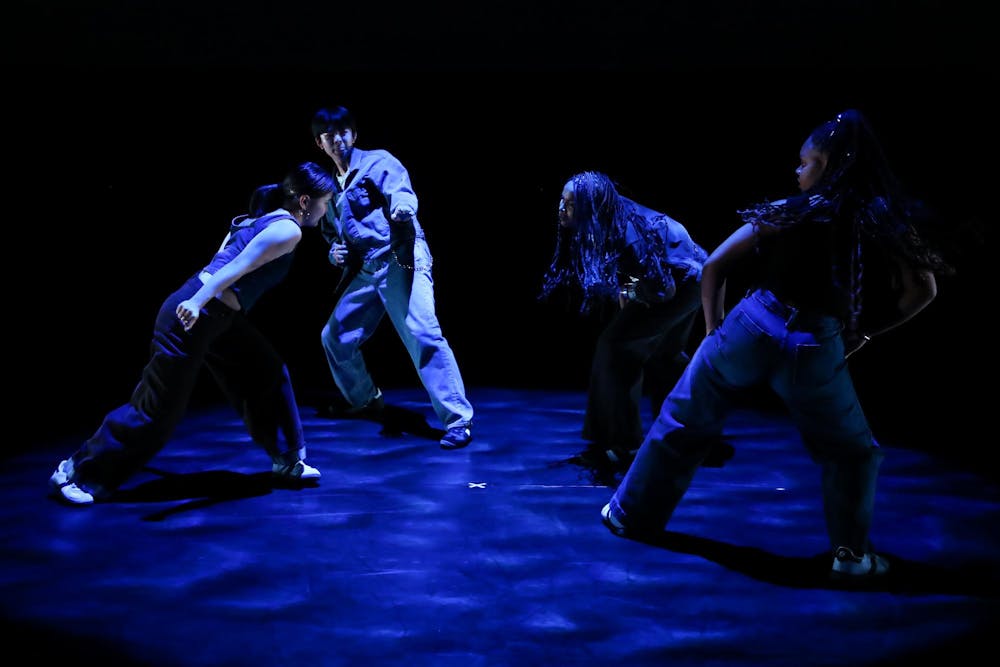Tierra Lewis ’25 and Sophie Main ’25 are pursuing a senior thesis in dance — each choreographing a dance piece with small casts. Their show “Momentum” is composed of Lewis’s piece, “Sync” and Main’s piece, “Tank.” I sat down with them to chat about their journeys with these performances.
This interview has been edited for clarity and concision.
The Daily Princetonian:
Could you please tell us a little bit about yourself, what dance means to you, and how it’s manifested in your life?
Tierra Lewis:
I’m a senior from Southern California in the SPIA department and getting certificates in American Studies and Dance. Dance means a lot of things. It’s been one of my favorite things at Princeton. It’s helped me meet many people and a lot of my closest friends. What I focus on is hip-hop, street dance, club dance, and Black art styles. I’ve enjoyed learning about the history and technique that goes into all these different styles and trying to bring them all together.
Sophie Main:
I’m a senior in the Art and Archaeology department. I’m receiving a minor in the dance program. Dance has always been with me. I was trained at the same studio from age three. I’m a proud member of BodyHype Dance Company, and it’s defined my Princeton experience. I also think the dance program has helped me shape who I am as a dancer. I don’t think I found who I was as a dancer or choreographer until Princeton, and I’m so thankful I found it here.

DP:
Tierra, can you tell us about your dance piece and what the title “Sync” means to you?
TL:
The piece is about different spaces in which people dance together. One space is the in-person environment, including physical spaces where people dance in person with others. We also look at online or digital environments where dance happens. This includes things like social media, where people may be physically dancing together, but it’s for a camera. They’re not really engaging with each other — they’re engaging with the camera. The piece’s final section is putting those two spaces together. The name “Sync” comes from looking at the digital environment. It also shows us dancing together in sync. There are multiple meanings to “Sync.”

DP:
Sophie, can you tell us about your piece and what the title “Tank” means to you?
SM:
I had a performance art concept tied to my visual artwork. Once I started working with the dancers, I realized it was about their virtuosity and this act of watching them do choreography I could never even dream of executing. The name “Tank” came from an exercise I did last spring where we were mirroring the fish bowl aesthetic. “Tank” means terrarium to me, but I open it up to other meanings. I think the act of looking is key: looking at dancers doing impossible choreography to the best of their ability, and sometimes failing.
DP:
What would you say was the most enlightening or fulfilling part of the process for you?
TL:
I’m doing a dance thesis based on hip-hop, and since there haven’t been many of those at Princeton, it was enlightening to talk to those few other people who have done this kind of work before and get their experience on it. I talked with two alumni, one named Lauren, who did the first hip-hop thesis in 2019. I also talked with Liam Lynch, who helps teach the co-curricular classes through the Lewis Center for the Arts. They were really helpful in giving specific advice related to hip-hop, like what I should be doing and how it’s different from what other people might be doing for their theses based on the style.
DP:
What would you say was the most challenging part of the process for you?
SM:
Having a piece that is 35 minutes long is so much longer than anything I’ve ever created, and this is the most impressive and massive theater I’ve ever worked with. Going from student dance groups to more individual solos for the dance program, I went in blind with how to make an evening-length piece. Without my dancers, who helped me through the process, I’m not sure how it would have gone.
DP:
How did you decide that your two distinct pieces would pair well together, and what does the title of the show “Momentum” mean to the both of you?
SM:
I feel very grateful to work with Tierra, and I think our pieces fit well together. The dance program decides what pieces get paired up, and I think the theme of performance and viewership tied us together. For mine, it’s a general sense of enclosure and active audience. Our alley setup, which is the audience on both sides looking inward and at each other, really plays into that. We are both connected with our individual titles, but a sense of movement towards and through is really important.
TL:
I agree that our pieces are definitely very similar in their themes, so I feel that was a good pair. For the title, I wanted to look at the history of hip-hop and how hip-hop has gained momentum. It still has a lot of places to go from what it is now. Overall, both of our pieces build toward energy as well.
DP:
How did you both choose the set of dancers in each of your pieces?
TL:
My cast includes three other people and me. It’s a mix of people I’ve met through student-run dance companies and classes through the dance department, as well as at the beginning of the semester through open workshops that we held, where anyone could come and learn about our piece and process.
SM:
I came into the workshop portion in September with three dancers I really wanted in my cast. During open workshops, I met a freshman who ended up joining the cast. I wanted people who had training in contemporary dance, but also people who could bring a sense of maturity with their dancing. That’s something I looked for, and I was so surprised to find a freshman, Renata, who is controlling the space by anyone’s measure. She’s so talented, and the workshops helped open my mind to more dancers on campus.
DP:
What do you hope the audience will take away from your dance pieces?
SM:
I hope the audience takes away how talented dancers at Princeton are and how hard they work. I’m deeply proud of my cast and their work ethic. I hope that appreciation and, hopefully, some fascination with the process is gleaned by the audience. I also think the audience is a part of dance. Reflecting is not only about the dancers approaching the dance but how they operate as audience members — how they feel seen or not seen by the material.
TL:
Hip-hop is generally not something you see in a senior thesis project. So this is the second one of its kind. It’s having that space where people can interact with something that should not be taken lightly. My cast and I worked hard on the foundations and techniques, and we tried to embody all these different environments. We reflected on their interaction and engagement with black art forms while also enjoying the piece and having fun.
DP:
Make sure to check out Tierra and Sophie this weekend at Momentum, playing on Feb. 20, 21, and 22 at 8:30 p.m. at Hearst Dance Theater in the Lewis Arts complex.
Monica Zepeda is a contributing writer for The Prospect and a member of the Class of 2028. She can be reached at mz9063[at]princeton.edu
Please send any corrections to corrections@dailyprincetonian.com.








